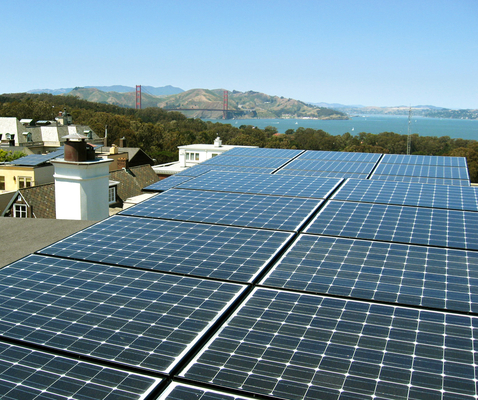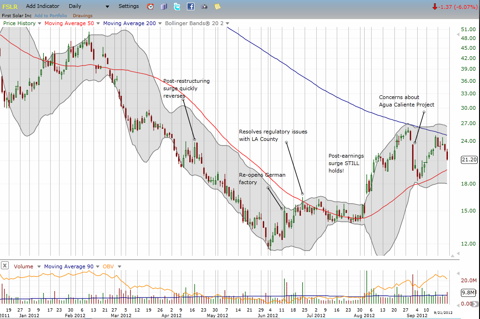Crowned with three gables and painted in hues of gray and white, the suburban home in Lake Forest doesn't look much like the domicile of the future.
But as summer heat radiates off the fresh asphalt outside, the home runs comfortably at full tilt indoors. Recessed lights shine, radios blare and air-conditioned splendor greets hot skin. Despite all systems going, the property is producing more electricity than it can consume on a warm summer day — and that's the goal.
Unveiled late last year, the ZeroHouse model by Los Angeles builder KB Home embodies the industry's bid to move beyond the one-of-a-kind vanity project and make subdivision building a green practice. Net-zero homes such as the one KB Home has built are highly efficient properties paired with renewable energy technology such as solar panel systems, resulting in homes so green they produce at least as much juice as they consume.
California has had expansive policies mandating and incentivizing the development of greener new homes for years, but the implementation of those goals has been slowed by the weak housing market and the dearth of new construction.
With the market healing, and with builders trying to distinguish their products from homes they built as recently as six years ago, companies such as KB Home, Lennar Corp. and others are rolling out more options for consumers and increasingly making energy efficiency part of the basic package.
"For new homes, it is becoming more of a standard feature, and the reason is that builders need a compelling reason that somebody should buy a new home rather than a resale," said Patrick Duffy, principal for research firm MetroIntelligence Real Estate Advisors.
In coming years, California guidelines will call for ever more energy-efficient homes, with the goal of having all homes built in 2020 being net zero. For now, net zero remains more of an aspiration for the industry, though experts say builders are increasingly making standard some of the fundamental elements of green design, including more efficient appliances, lighting and solar panel systems.
In Southern California, KB Home has made solar systems standard. Lennar, Pulte Homes and Pardee Homes offer solar home projects. ABC Green Home of Newport Beach will be building a net-zero home to showcase green technology for consumers. Clarum Homes in Palo Alto is a custom builder that has gained praise for incorporating energy efficiency and passive solar features into homes with modernist flourishes.
Moving to Southern California from Maryland, Ray and Linda Frilot wanted to buy a new home because the resales needed too much work, from $20,000 to $50,000 worth of remodeling. They were attracted to the solar offerings at KB Home's Fox Hollow at the Crown Valley Village development in Murrieta, said Ray Frilot, a retired government worker and former military man.
Aside from a 2.25-kilowatt solar system, the home has a tankless hot water heater, some LED lighting and Energy Star appliances. Although the home wasn't advertised as a net-zero property when they bought it, he and his wife conserve so much energy from habits picked up while living in Germany that the electricity bill from Southern California Edison Co. is close to zero.
"The energy that I don't use Edison buys from me," he said. "It looks like I may not have an electric bill next year, because the electricity, all of it is going to keep on adding to that credit. I still have to pay delivery and handling charges, but that is just a couple of bucks a month."
Net-zero homes couldn't exist without this type of subsidization, called net metering. Net-zero homeowners rely on power from utilities at night but get credit for the energy they produce during the day that they don't consume.
Net metering allows homeowners to get credit for the power they produce at a retail rate rather than a wholesale rate. There is currently a cap on net metering programs for that reason. Although the cap won't be hit any time soon, experts said, the future of net metering is uncertain.
Environmentalists began pushing for California to mandate that new homes come with renewable energy systems in the early 2000s, as the technology became more scalable and available.
The effort to get builders to build green morphed into state law SB 1, which focused on incentives and created the Million Solar Roofs Initiative, calling for the creation of 3,000 megawatts of new, solar-generated electricity by 2016.
Gov. Jerry Brown has increased that goal to 12,000 megawatts, or roughly the equivalent of 12 nuclear power plants, according to the group Environment California. A thousand megawatts of solar energy could power about 250,000 homes.
Also created as part of the law was the California Solar Initiative, which uses rebates to promote renewable energy use in previously owned homes, as well as commercial, agricultural, government and nonprofit buildings. The similar New Solar Homes Partnership targets new houses.
"Unfortunately, as soon as the bill was passed, we had the housing market collapse, so everything stopped," said Bernadette Del Chiaro, director of clean energy and global warming programs at Environment California. "As the housing market ticks back up again, I would expect solar to pick back up again."
In 2008, California energy regulators adopted a long-term plan that called for having all new residential buildings achieve zero net energy use by 2020 and having all commercial buildings achieve zero net energy use by 2030.
Regulators now mandate solar-ready roofs, more efficient lights and better-insulated hot water pipes, among a variety of other requirements. Despite the rebates that California provides, the tightening of requirements could make new homes more costly.
"It is kind of a double-edged sword because the construction costs of these new homes get passed on to the new home builder," said Christopher G. Cardinale, an attorney at Alvarez-Glasman & Colvin, a firm that specializes in real estate. "In a tough economy, there is always that risk-reward for new environmental standards."
There is evidence that consumers are growing increasingly interested in green features as an investment. A recent study by economists at UCLA and UC Berkeley found that a green label on a single-family California home provides a premium to a comparable home that isn't identified as using energy efficiently.
The researchers found that homes certified as energy efficient by Energy Star, LEED for Homes or GreenPoint Rated sold for about 9% more than other homes.
Researchers estimate that premium at about $34,800, based on the average $400,000 price of a standard home in California. The premium was significantly more than the cost of making a home energy efficient, estimated at about $4,000 to $10,000 for a 2,000-square-foot house. The premium also was bigger than the average $700 in annual utility-bill savings for owners of green homes.
Some economists and green building practitioners say that the building industry is still moving too slowly. Mark Broud, principal at the firm Real Estate Economics, said that builders in Japan, China and many European nations have employed more sophisticated building techniques for years, including the use of autoclaved aerated concrete, a type of high-tech material that replaces lumber in some cases.
"We have constructed with lumber for hundreds of years and lumber tends to be very inefficient," Broud said. "The construction techniques of homes need to change."
Others believe that mass production home building by its very nature is antithetical to constructing green properties and that strategies should focus on refurbishing previously owned properties or doing more infill building rather than new subdivisions.
Angela Brooks, a principal of architecture firm Brooks & Scarpa, is one of those critics. She and her husband, Lawrence Scarpa, the other principal in the firm, live in a super-green redesigned home.
Called the Solar Umbrella, inspired by Paul Rudolph's Umbrella House of 1953, the home has photovoltaic solar panels that form a canopy over the property and provide the residence with nearly all of its energy needs.
Preserving parts of the original property — a 1920s Venice house — the couple installed energy-efficient features including eco-friendly building materials and large sliding glass doors on the second floor to help improve the air flow. The home won several awards, including one in 2006 from the American Institute of Architects' Committee on the Environment.
"Tract housing in and of itself is kind of anti-environmental," Brooks said, adding that factors such as climate, orientation and design should be considered, and when homes are just plopped down, much can be lost. "Production home builders have really lost sight of the forest for the trees."
Nevertheless, green construction by large companies is becoming big business, particularly in California.
Anticipating that California will ultimately move toward more stringent energy policies, and that consumers will demand them, major builders have begun partnering with solar panel providers to equip their homes.
California company SunPower Corp. created a business unit for catering to new-home building in 2006. The company produces highly efficient black panels that on homes resemble skylights.
Matt Brost, national sales director for SunPower's new-home division, said equipping new homes with solar panels is one of the most effective ways of making homes more energy efficient because it costs less than adding panels to older homes.
"The cost at new construction is substantially lower because you have things working for you, a much higher rebate and builders buying in volume," Brost said.
Dan Bridleman, senior vice president for sustainability at KB Home, said big builders play an important role in creating more sustainable homes.
The company focuses on making the most energy-efficient home possible before adding a solar system. KB Home found an "inflection point" where the home was as energy efficient as it could be using available technology that could be bought in bulk, he said.
Few of the features of ZeroHouse in Lake Forest are obvious, including the model's insulation and wall assembly, low-E windows, LED lighting and Energy Star appliances. Even the solar panels look more like skylights than the gleaming armor that many envision.
Inside the KB Home model, an oversized flat-screen TV planted above the living room's fireplace shows the model home's cycle of energy consumption and production, graphed out in hourly segments.
By 2:15 p.m. on a warm summer afternoon, the model home had gobbled up 33.32 kilowatt-hours of electricity, including nighttime hours when the house draws from the grid. Its solar panel system had produced 20.21 kWh. As the sun moved across the sky, the home's analytics showed, production was outpacing consumption.
KB Home has yet to sell a ZeroHouse in Southern California as it is marketed, but buyers are attaining the net-zero goal, or very close to it, choosing energy-saving options that fit their lifestyles, executives said.
"We could take any one of our plans …," Bridleman said, "and we could make that house a net-zero house."
Source: http://www.latimes.com/business/realestate/la-fi-energy-homes-20120923,0,1367147.story
















